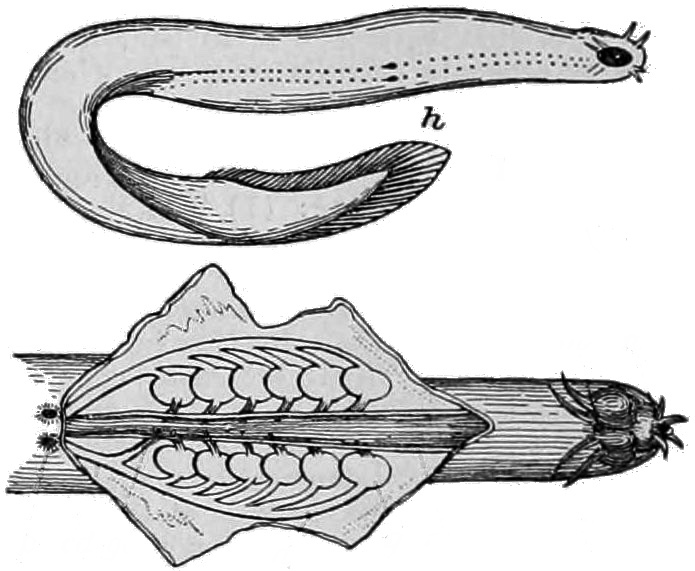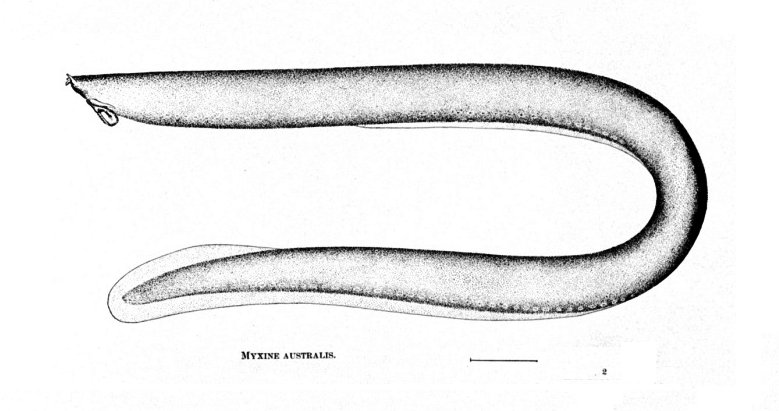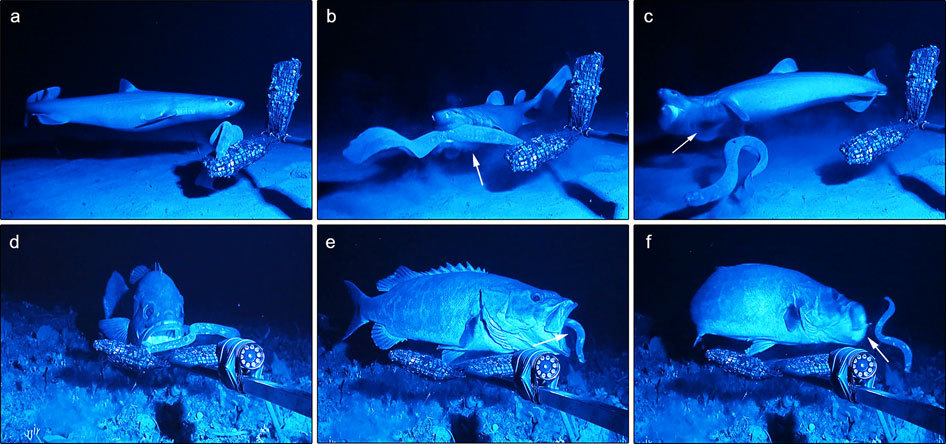|
Hagfish
Hagfish, of the Class (biology), class Myxini (also known as Hyperotreti) and Order (biology), order Myxiniformes , are eel-shaped Agnatha, jawless fish (occasionally called slime eels). Hagfish are the only known living Animal, animals that have a skull but no vertebral column, although they do have rudimentary vertebrae. Hagfish are marine animal, marine predators and scavengers that can defend themselves against other larger predators by releasing copious amounts of slime coat, slime from mucous glands in their skin. Although their exact relationship to the only other extant taxon, living group of Agnatha, jawless fish, the lampreys, was long the subject of controversy, genetic evidence suggests that hagfish and lampreys are more closely related to each other than to jawed vertebrates, thus forming the superclass Cyclostomi. The oldest-known stem group hagfish are known from the Pennsylvanian (geology), Late Carboniferous, around Moscovian (Carboniferous), 310 million years ... [...More Info...] [...Related Items...] OR: [Wikipedia] [Google] [Baidu] |
Myxine Glutinosa
''Myxine glutinosa'', also known as the Atlantic hagfish, is a type of Agnatha, jawless fish belonging to the class Myxini. Description The Atlantic hagfish may grow up to long, with no eyes and no jaws; its star-shaped mouth is surrounded by 6 mouth Barbel (anatomy), barbels. Their eyes also lack a lens and pigment (features found in the eyes of all other living vertebrates. There is a single gill slit on each side of the eel-like body. It has a total of 88–102 pores from which it can exude a slimy mucus. Hagfish have very flexible bodies which allow them to manipulate themselves into knots. The knots created by the hagfish remove mucus from the body, allow them to escape tight spaces, and pull potential prey from burrows, and because they have no opposable jaws it helps create leverage while they eat. Similar species A related species, the Gulf hagfish (''Eptatretus springeri''), occurs in the Gulf of Mexico. To distinguish these two types of hagfishes, we can look at the ... [...More Info...] [...Related Items...] OR: [Wikipedia] [Google] [Baidu] |
Eptatretus
''Eptatretus'' is a large genus of hagfish. Species There are currently 50 recognized species in this genus: * '' Eptatretus aceroi'' Polanco Fernández & Fernholm, 2014 (Acero's hagfish)Polanco Fernandez, A. & Fernholm, B. (2014): A New Species of Hagfish (Myxinidae: ''Eptatretus'') from the Colombian Caribbean. ''Copeia, 2014 (3): 530–533.'' * '' Eptatretus alastairi'' Mincarone & Fernholm, 2010 (Alastair's hagfish) * '' Eptatretus ancon'' H. K. Mok, Saavedra-Diaz & Acero P, 2001 * '' Eptatretus astrolabium'' Fernholm & Mincarone, 2010 (Astrolabe hagfish) * '' Eptatretus atami'' Dean, 1904 (Brown hagfish) * '' Eptatretus bischoffii'' A. F. Schneider, 1880 (Bischoff's hagfish) * '' Eptatretus bobwisneri'' Fernholm, Norén, S. O. Kullander, Quattrini, Zintzen, C. D. Roberts, H. K. Mok & C. H. Kuo, 2013 (Bob Wisner's hagfish)Fernholm, B., Norén, M., Kullander, S.O., Quattrini, A.M., Zintzen, V., Roberts, C.D., Mok, H.-K. & Kuo, C.-H. (2013): Hagfish phylogeny ... [...More Info...] [...Related Items...] OR: [Wikipedia] [Google] [Baidu] |
Agnatha
Agnatha (; ) or jawless fish is a paraphyletic infraphylum of animals in the subphylum Vertebrata of the phylum Chordata, characterized by the lack of jaws. The group consists of both extant taxon, living (Cyclostomi, cyclostomes such as hagfishes and lampreys) and Extinction, extinct clades (e.g. conodonts and Cephalaspidomorphi, cephalaspidomorphs, among others). They are sister taxon, sister to vertebrates with jaws known as gnathostomes, who evolution, evolved from jawless ancestors during the early Silurian by developing folding joint, articulations in the first pairs of gill arches. Sequencing, Molecular data, both from rRNA and from mtDNA as well as Embryology, embryological data, strongly supports the hypothesis that both groups of living agnathans, hagfishes and lampreys, are more closely related to each other than to Gnathostomata, jawed fish, forming the Class (biology), superclass Cyclostomi. The oldest fossil agnathans appeared in the Cambrian. Living jawless fish c ... [...More Info...] [...Related Items...] OR: [Wikipedia] [Google] [Baidu] |
Myxine
''Myxine'' is a genus of hagfish, from the Greek μυξῖνος (''myxinos'', "slimy"). It is the type genus of the class Myxini. In 2021, three new species of ''Myxine'' were described from the Galápagos including '' M. phantasma'', the only species of ''Myxine'' to not have melanin-based pigments. Species * '' Myxine affinis'' Günther, 1870 (Patagonian hagfish) * '' Myxine australis'' Jenyns, 1842 (southern hagfish) * '' Myxine capensis'' Regan, 1913 (Cape hagfish) * '' Myxine circifrons'' Garman, 1899 (whiteface hagfish) * '' Myxine debueni'' Wisner & C. B. McMillan, 1995 (Magellan hagfish) * '' Myxine fernholmi'' Wisner & C. B. McMillan, 1995 (Fernholm's hagfish) * '' Myxine formosana'' H. K. Mok & C. H. Kuo, 2001 (Formosa hagfish) * '' Myxine garmani'' D. S. Jordan & Snyder, 1901 (Garman's hagfish) * ''Myxine glutinosa'' Linnaeus, 1758 (Atlantic hagfish) *''Myxine greggi'' (Gregg's hagfish) * '' Myxine hubbsi'' Wisner & C. B. McMillan, 1995 (Hubbs' hagfish ... [...More Info...] [...Related Items...] OR: [Wikipedia] [Google] [Baidu] |
Myxinikela
''Myxinikela'' is an extinct genus of stem-hagfish known from the Late Carboniferous of Illinois, USA. It is the earliest definitive hagfish known from fossil remains, and one of only two alongside the Cretaceous crown-group hagfish '' Tethymyxine''. ''Myxinikela'''s anatomy displays basal features of cyclostomes (cartilaginous branchial baskets, separation between esophageal and branchial passages, and a well-differentiated midline finfold), giving it a somewhat lamprey Lampreys (sometimes inaccurately called lamprey eels) are a group of Agnatha, jawless fish comprising the order (biology), order Petromyzontiformes , sole order in the Class (biology), class Petromyzontida. The adult lamprey is characterize ...-like appearance, but it also has numerous derived traits of hagfishes such as a nasohypophyseal aperture, large velar cavity, and a cardinal heart; due to this, ''Myxinikela'' can be considered a transitional form between basal cyclostomes and modern hagfishes. ... [...More Info...] [...Related Items...] OR: [Wikipedia] [Google] [Baidu] |
Marine Animal
Marine life, sea life or ocean life is the collective ecological communities that encompass all aquatic animals, aquatic plant, plants, algae, marine fungi, fungi, marine protists, protists, single-celled marine microorganisms, microorganisms and associated marine virus, viruses living in the saline water of marine habitats, either the sea water of marginal seas and oceans, or the brackish water of coastal wetlands, lagoons, estuary, estuaries and inland seas. , more than 242,000 marine species have been documented, and perhaps two million marine species are yet to be documented. An average of 2,332 new species per year are being described. Marine life is studied scientifically in both marine biology and in biological oceanography. By volume, oceans provide about 90% of the living space on Earth, and served as the cradle of life and vital biotic sanctuaries throughout Earth's geological history. The earliest known life forms evolved as anaerobe, anaerobic prokaryotes (archaea ... [...More Info...] [...Related Items...] OR: [Wikipedia] [Google] [Baidu] |
Tethymyxine
''Tethymyxine'' is an extinct genus of hagfish known from the Late Cretaceous (Cenomanian) of Lebanon. It contains a single species, ''Tethymyxine tapirostrum'', known from a single fossil specimen. It is the oldest crown group hagfish known from fossil remains. It is known from Hjoula, a prominent outcrop of the Sannine Formation. As its specific epithet suggests, this formation consists of sediments from the ancient Tethys Ocean, and is a lagerstätte with numerous extremely well-preserved specimens, including soft-bodied animals such as hagfish that are otherwise rarely fossilized. ''Tethymyxine'''s fossil preserves a row of 133 slime glands, indicating its close relationship to modern hagfish, although it has some notable differences, such as smaller facial tentacles, a more anterior branchial pouch, and a less-expanded caudal fin. The presence of slime glands indicates that hagfish slime may have originally evolved as a defense against now-extinct marine predators such as p ... [...More Info...] [...Related Items...] OR: [Wikipedia] [Google] [Baidu] |
Rubicundus
''Rubicundus'' is a genus of hagfishes, the only extant member of the subfamily Rubicundinae. All species in it were formerly classified in ''Eptatretus''. ''R. eos'', ''R. lakeside'', and ''R. rubicundus'' are known from single specimens caught in the Tasman Sea, Galápagos, and Taiwan, respectively. They are named after the distinctive red coloration that all species share. They represent the sister lineage to all other extant lineages of hagfishes, and may represent the sister group to the Cretaceous fossil hagfish ''Tethymyxine'', from which they potentially diverged during the Late Jurassic or Early Cretaceous. Both ''Rubicundus'' and ''Tethymyxine'' share an elongate snout, indented barbels, and numerous slime glands. Phylogenetic studies indicate that the Rubicundinae lineage may have diverged from other extant hagfishes during the Permian The Permian ( ) is a geologic period and System (stratigraphy), stratigraphic system which spans 47 million years, from the end of ... [...More Info...] [...Related Items...] OR: [Wikipedia] [Google] [Baidu] |
Slime Coat
The slime coat (also fish slime, mucus layer or slime layer) is the coating of mucus covering the body of all fish. An important part of fish anatomy, it serves many functions, depending on species, ranging from Fish locomotion, locomotion, Parental care#In fish, care and feeding of offspring, to resistance against Fish diseases and parasites, diseases and parasites. The mucin making up the slime coat is secreted by goblet cells in the fish's epidermis. The slime contains a variety of antimicrobial peptides and other antimicrobial components such as lysozyme and C-reactive protein. It contains mycosporine-like amino acids to protect from ultraviolet radiation. Locomotion The slime coat of some fish aids in more efficient swimming by reducing Drag (physics), drag, attributed to the Toms effect. Slime can reduce the friction experienced by the fish by up to 65%. Generally, the faster the fish, the greater reduction in drag provided by the slime, but there are a few exceptions. I ... [...More Info...] [...Related Items...] OR: [Wikipedia] [Google] [Baidu] |
Neomyxine
''Neomyxine'' is a genus of hagfish found in the Pacific Ocean around New Zealand New Zealand () is an island country in the southwestern Pacific Ocean. It consists of two main landmasses—the North Island () and the South Island ()—and List of islands of New Zealand, over 600 smaller islands. It is the List of isla .... Species Two species in this genus are recognized: * '' Neomyxine biniplicata'' ( L. R. Richardson & Jowett, 1951) (slender hagfish) * '' Neomyxine caesiovitta'' A. L. Stewart & Zintzen, 2015 (blueband hagfish) Zintzen, V., Roberts, C.D., Shepherd, L., Stewart, A.L., Struthers, C.D., Anderson, M.J., McVeagh, M., Noren, M. & Fernholm, B. (2015): Review and phylogeny of the New Zealand hagfishes (Myxiniformes: Myxinidae), with a description of three new species. ''Zoological Journal of the Linnean Society, 174 (2): 363–393.'' References Myxinidae jawless fish genera {{jawless-fish-stub ... [...More Info...] [...Related Items...] OR: [Wikipedia] [Google] [Baidu] |
Nemamyxine
''Nemamyxine'' is a genus of hagfish Hagfish, of the Class (biology), class Myxini (also known as Hyperotreti) and Order (biology), order Myxiniformes , are eel-shaped Agnatha, jawless fish (occasionally called slime eels). Hagfish are the only known living Animal, animals that h .... Species Two recognized species are placed in this genus: * '' Nemamyxine elongata'' L. R. Richardson, 1958 (bootlace hagfish) Zintzen, V., Roberts, C.D., Shepherd, L., Stewart, A.L., Struthers, C.D., Anderson, M.J., McVeagh, M., Noren, M. & Fernholm, B. (2015): Review and phylogeny of the New Zealand hagfishes (Myxiniformes: Myxinidae), with a description of three new species. ''Zoological Journal of the Linnean Society, 174 (2): 363–393.'' * '' Nemamyxine kreffti'' C. B. McMillan & Wisner, 1982 (Krefft's hagfish) References Myxinidae jawless fish genera {{jawless-fish-stub ... [...More Info...] [...Related Items...] OR: [Wikipedia] [Google] [Baidu] |
Notomyxine
''Notomyxine'' is a monospecific genus of hagfish that occurs in the Atlantic Ocean off the southern coasts of South America. The only member of the genus is ''Notomyxine tridentiger''. It can be found in the temperate waters of the Southeast Pacific and Southwest Atlantic, as well as the southern coasts of South America. It can reach a maximum length of 57 cm. Conservation status ''Notomyxine tridentiger'' has been found only along the Argentinean continental shelf and southern Chile and has not been reported since 1968. Its shallow depth range and medium body size make it very likely to be exposed to extensive trawling activities throughout its range, although it has not been reported in any bycatch surveys. It is listed as data deficient by the IUCN. More research is needed to understand the distribution, population status, habitat, biology, ecology, and impact of potential major threats to this species. Habitat This species is located off the south coast of South Ame ... [...More Info...] [...Related Items...] OR: [Wikipedia] [Google] [Baidu] |




